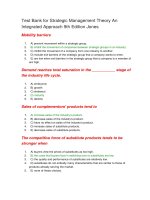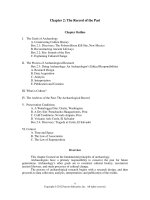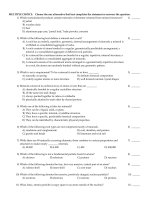Test bank for the criminal event an introduction to criminology in canada 5th edition by sacco
Bạn đang xem bản rút gọn của tài liệu. Xem và tải ngay bản đầy đủ của tài liệu tại đây (155.58 KB, 9 trang )
Test Bank for The Criminal Event An Introduction to Criminology in Canada 5th Edition by Sacco
Full file Chapter
at />1: What Is Criminology?
MULTIPLE CHOICE
1. Which of the following phrases best summarizes modern Canadian criminology?
A. an extension of the criminal justice system because most research is government funded
B. a narrow, uni-disciplinary approach that produces empirical, legally oriented research
C. a broad, interdisciplinary approach that draws on both natural and social sciences
D. a sociologically informed discipline because most criminologists are trained sociologists
ANS: C
PTS: 1
BLM: Higher Order
2. Which of the following statements best describes a major difference between Canadian criminology
and European criminology?
A. European criminology is legally oriented; Canadian criminology is interdisciplinary.
B. Canadian criminology is research oriented; European criminology is policy oriented.
C. European criminology is interdisciplinary; Canadian criminology is a distinct discipline.
D. Canadian criminology is policy oriented; European criminology is research oriented.
ANS: A
PTS: 1
BLM: Higher Order
3. Canadian criminological research receives both corporate and state funding. Which of the following is
a concern that critics have raised about this situation?
A. It discourages the development of an interdisciplinary criminology.
B. It lowers standards for entrance into graduate programs.
C. It weakens the quality of empirical, criminological research.
D. It plays an important role in political agenda-setting.
ANS: D
PTS: 1
BLM: Higher Order
4. Which of the following best differentiates Canadian and U.S. crime media?
A. The United States has higher crime rates, but crime coverage is similar in both countries.
B. Canada has lower crime rates and therefore less crime coverage than the United States.
C. Canada has higher crimes rates but less crime coverage than the United States.
D. Canada has higher crime rates and therefore more crime coverage than the United States
ANS: A
PTS: 1
BLM: Higher Order
5. Which of the following statements best describes the relationship between types of crimes and amount
of news coverage?
A. The type of crime reported coincides with that committed.
B. Violent, rare crimes are most often reported in news media.
C. Media attention to crime is independent of specific types of offences.
D. Frequently committed crimes are reported most often in news media.
ANS: B
PTS: 1
BLM: Higher Order
6. In general, which of the following does crime news tend to do?
A. focus attention on the later stages of criminal justice processing (e.g., sentencing)
B. ignore earlier stages of criminal justice processing (e.g., detection)
C. portray police as far less effective than they are
D. exaggerate the proportion of offences that result in arrest
ANS: D
PTS: 1
The Criminal Event, 5e
Full file at />
BLM: Higher Order
1-1
Test Bank for The Criminal Event An Introduction to Criminology in Canada 5th Edition by Sacco
Full file at />7. Voumvakis and Ericson’s research on “crime waves” related to attacks against women in Toronto
revealed that newspaper accounts tended to do which of the following? Choose the best answer.
A. ignore the biology of offenders
B. emphasize the need for a lenient response from the criminal justice system
C. ignore the pathology of victims
D. emphasize the ways in which the victims’ actions placed them at risk
ANS: D
PTS: 1
BLM: Higher Order
8. Crime can be a form of social control. Which of the following theorists is most likely to agree with this
statement?
A. Emile Durkheim
B. Joel Best
C. Donald Black
D. Elizabeth Comack
ANS: C
PTS: 1
BLM: Higher Order
9. Which of the following groups has the greatest influence on the content of crime news?
A. police
B. victims
C. offenders
D. criminologists
ANS: A
PTS: 1
BLM: Higher Order
10. Which of the following describes how television offenders differ from real-life offenders?
A. Television offenders tend to be female whereas real-life offenders tend to be male.
B. Television offenders are likely poor whereas real-life offenders are often affluent.
C. Real-life offenders tend to be younger than television offenders.
D. Real-life offenders tend to be older than television offenders.
ANS: C
PTS: 1
BLM: Higher Order
11. Which of the following describes the ingenuity fallacy, encouraged by popular culture?
A. belief that offenders are fundamentally different from the rest of us
B. belief that crime definitions differ more markedly between cultures than they do
C. belief that the typical offender is a criminal genius
D. belief that strange and violent crimes are typical
ANS: C
PTS: 1
BLM: Remember
12. For consensus theorists, which is the most important factor contributing to the making of criminal
laws?
A. class struggle
B. patriarchy
C. power
D. collective interests
ANS: D
PTS: 1
The Criminal Event, 5e
Full file at />
BLM: Higher Order
1-2
Test Bank for The Criminal Event An Introduction to Criminology in Canada 5th Edition by Sacco
Full file at13. />Suppose that you are a liberal feminist. Which of the following statements is most likely to
characterize your theoretical position?
A. Patriarchy is the source of gender inequality.
B. Socio-economic status shapes gender inequality.
C. Legal definitions reflect and perpetuate gender inequality.
D. Women’s position can be improved through changes to the law.
ANS: D
PTS: 1
BLM: Higher Order
14. Which of the following best describes the relationship between police and journalists?
A. antagonistic
B. beneficial to both
C. exploitative
D. lacking in significance
ANS: B
PTS: 1
BLM: Higher Order
15. Which of the following statements best explains why crimes against business are deemed less
newsworthy than other types of crimes?
A. They are complex, less dramatic, and more difficult to personalize.
B. They are simplistic, less dramatic, and more difficult to generalize.
C. They are too frequent to garner public interest.
D. They are relatively rare.
ANS: A
PTS: 1
BLM: Higher Order
16. Crime in television drama, like crime in the news, tends to do or be which of the following?
A. to be disproportionately violent
B. to emphasize frequently occurring crimes
C. to emphasize socio-economic explanations of crime
D. to be proportionately violent
ANS: A
PTS: 1
BLM: Higher Order
17. Which of the following lists best describes general characteristics of crime media?
A. complexity, personification, exaggeration
B. status quo orientation, simplicity, generalization
C. personalization, complexity, atypicality
D. atypicality, simplicity, personification
ANS: D
PTS: 1
BLM: Higher Order
18. With respect to crime news reporting, emotion is often emphasized at the expense of which of the
following?
A. detail
B. truth
C. rational discourse
D. accuracy
ANS: C
PTS: 1
The Criminal Event, 5e
Full file at />
BLM: Remember
1-3
Test Bank for The Criminal Event An Introduction to Criminology in Canada 5th Edition by Sacco
Full file 19.With
at />respect to crime media, the use of music, personal detail, and point-of-view photography encourages
the viewer to take the role of which of the following parties to a criminal event?
A. the police
B. the offender
C. the bystander
D. the victim
ANS: D
PTS: 1
BLM: Higher Order
20. From which of the following sources do most people claim to get the greatest amount of their crime
information?
A. friends and family
B. academic reports and interviews
C. television dramas and movies
D. newspapers and media reports
ANS: A
PTS: 1
BLM: Remember
21. Which of the following people argued that concerns over Halloween sadists reflect public anxieties
regarding the vulnerability of children to child abuse and threats to personal safety posed by
anonymous strangers?
A. Elizabeth Comack
B. Robert Merton
C. Donald Black
D. Joel Best
ANS: D
PTS: 1
BLM: Higher Order
22. Which of the following statements about who within the Canadian population is more likely to be
murdered is supported by criminological research?
A. Single, socially disadvantaged females are more likely to be murdered.
B. Affluent, white males are more likely to be murdered.
C. Young, single females are more likely to be murdered.
D. Young, socially disadvantaged males are more likely to be murdered.
ANS: D
PTS: 1
BLM: Higher Order
23. Which of the terms below can be defined as linguistic categories or general terms that people use to
classify objects, persons, relationships, or events?
A. propositions
B. variables
C. concepts
D. theories
ANS: C
PTS: 1
BLM: Remember
24. Which of the following is synonymous with mens rea?
A. Criminal intent
B. Actus Reus
C. Criminal action
D. Justification
ANS: A
PTS: 1
The Criminal Event, 5e
Full file at />
BLM: Higher Order
1-4
Test Bank for The Criminal Event An Introduction to Criminology in Canada 5th Edition by Sacco
Full file 25.In
at />summer 2010, 11-year-old Nancy wilfully stabbed her friend with a kitchen knife. Could Nancy’s
behaviour be regulated by the Youth Criminal Justice Act (YCJA)?
A. No, the YCJA was replaced by the Young Offenders Act (YOA) in 2003.
B. No, according to the YCJA, Nancy is not a youth.
C. Yes, because both mens rea and actus reus were present.
D. Yes, because she acted with criminal intent.
ANS: B
PTS: 1
BLM: Higher Order
26. With which of the following individuals is consensus theory most closely associated?
A. Thorsten Sellin
B. Elizabeth Comack
C. Donald Black
D. Emile Durkheim
ANS: D
PTS: 1
BLM: Higher Order
27. Someone who makes assertions about the existence of a problem that requires a policy solution could
be best described as which of the following?
A. moral entrepreneur
B. policy entrepreneur
C. claims-maker
D. legal activist
ANS: C
PTS: 1
BLM: Higher Order
28. Child and elder abuse are best described as which of the following types of issues?
A. adversary
B. valour
C. victim
D. valence
ANS: D
PTS: 1
BLM: Higher Order
29. When did feminist criminology emerge?
A. 1920s and 1930s
B. 1940s and 1950s
C. 1960s and 1970s
D. 1980s and 1990s
ANS: C
PTS: 1
BLM: Remember
30. Suppose that you are a Marxian feminist interpreting wife assault. Which of the following would you
be most likely to argue?
A. The racial and ethnic character of social life worsens the problems of misogynistic
violence.
B. Wife assault affects all women.
C. Class position worsens the problems of misogynistic violence.
D. Systemic patriarchy is at the root of misogynistic violence.
ANS: C
PTS: 1
The Criminal Event, 5e
Full file at />
BLM: Higher Order
1-5
Test Bank for The Criminal Event An Introduction to Criminology in Canada 5th Edition by Sacco
Full file SHORT
at />ANSWER
1. Distinguish between crimes mala in se and crimes mala prohibita. Provide an example of each to
demonstrate your understanding.
ANS:
Answers will vary.
PTS: 1
BLM: Higher Order
2. Identify and explain three circumstances that must be present for an act to be considered criminal.
ANS:
Answers will vary.
PTS: 1
BLM: Higher Order
3. Differentiate between crime as a violation of norms and crime as a violation of law. Use examples to
demonstrate your understanding.
ANS:
Answers will vary.
PTS: 1
BLM: Higher Order
4. What does it mean to say that news organizations and policing organizations have a symbiotic
relationship? What are some implications of this relationship?
ANS:
Answers will vary.
PTS: 1
BLM: Higher Order
5. Briefly explain three general characteristics of crime media. Provide an example of each to
demonstrate your understanding.
ANS:
Answers will vary.
PTS: 1
BLM: Higher Order
6. Explain the concept of random violence and describe three problematic assumptions associated with
this conceptualization.
ANS:
Answers will vary.
PTS: 1
BLM: Higher Order
The Criminal Event, 5e
Full file at />
1-6
Test Bank for The Criminal Event An Introduction to Criminology in Canada 5th Edition by Sacco
Full file at />7. Marcus Felson (2002) has identified ten crime fallacies derived from popular culture. Identify and
explain three of Felson’s fallacies and provide an example of each to demonstrate your understanding.
ANS:
Answers will vary.
PTS: 1
BLM: Higher Order
8. Identify and differentiate between the three foundations on which criminology is built.
ANS:
Answers will vary.
PTS: 1
BLM: Remember
9. Identify and distinguish three criminal defences that can be advanced in a court of law. Use examples
to demonstrate your understanding.
ANS:
Answers will vary.
PTS: 1
BLM: Higher Order
10. Identify and explain two major feminist concerns with respect to traditional approaches to the study of
crime.
ANS:
Answers will vary.
PTS: 1
BLM: Higher Order
ESSAY
1. Identify and explain the conceptual limitations of offender-centred approaches to the study of crime.
How does the concept of the criminal event address these limitations?
ANS:
Answers will vary.
PTS: 1
BLM: Higher Order
2. Sharon was mugged while waiting for a bus. She concluded she was “at the wrong place at the wrong
time.” Evaluate and critique Sharon’s statement. How would you summarize its problematic nature to
Sharon and others who hold similar views?
ANS:
Answers will vary.
PTS: 1
BLM: Higher Order
The Criminal Event, 5e
Full file at />
1-7
Test Bank for The Criminal Event An Introduction to Criminology in Canada 5th Edition by Sacco
Full file at />3. Discuss the empirical case for crime profiling. Why does belief in the efficacy of crime profiling
persist despite evidence to the contrary?
ANS:
Answers will vary.
PTS: 1
BLM: Higher Order
4. Crime can be conceptualized in a number of different ways. Compare and contrast three ways that
crime is conceptualized in the Canadian context.
ANS:
Answers will vary.
PTS: 1
BLM: Higher Order
5. Identify and explain the two major theoretical orientations toward the emergence of criminal law in
Canada. How do the assumptions of each perspective differ? How do they overlap?
ANS:
Answers will vary.
PTS: 1
BLM: Higher Order
6. What is claims-making, who is a claims-maker, and what two factors affect the claims-making
process?
ANS:
Answers will vary.
PTS: 1
BLM: Higher Order
7. Why is it problematic to speak of the feminist perspective? Identify and explain some common
assumptions that feminist theorists share.
ANS:
Answers will vary.
PTS: 1
BLM: Higher Order
8. How do liberal, Marxian, and radical feminists approach the problem of domestic violence in Canada?
Explain each of these strands of feminism, and explain why each approaches this problem differently.
ANS:
Answers will vary.
PTS: 1
BLM: Higher Order
The Criminal Event, 5e
Full file at />
1-8
Test Bank for The Criminal Event An Introduction to Criminology in Canada 5th Edition by Sacco
Full file at />9. Who argued that crime can be understood as a form of social control? What does it mean to say that
crime is a form of social control? Use examples to demonstrate your understanding.
ANS:
Answers will vary.
PTS: 1
BLM: Higher Order
10. What characterizes the modern study of criminology in the Canadian context? How does criminology
in Canada differ from other models with respect to research practice?
ANS:
Answers will vary.
PTS: 1
BLM: Higher Order
11. Identify and explain factors that shape the content of crime news. How does the content of crime news
create a skewed understanding of crime among media consumers?
ANS:
Answers will vary.
PTS: 1
BLM: Higher Order
12. Drawing on empirical research, explain the public’s fascination with crime news.
ANS:
Answers will vary.
PTS: 1
BLM: Higher Order
The Criminal Event, 5e
Full file at />
1-9









